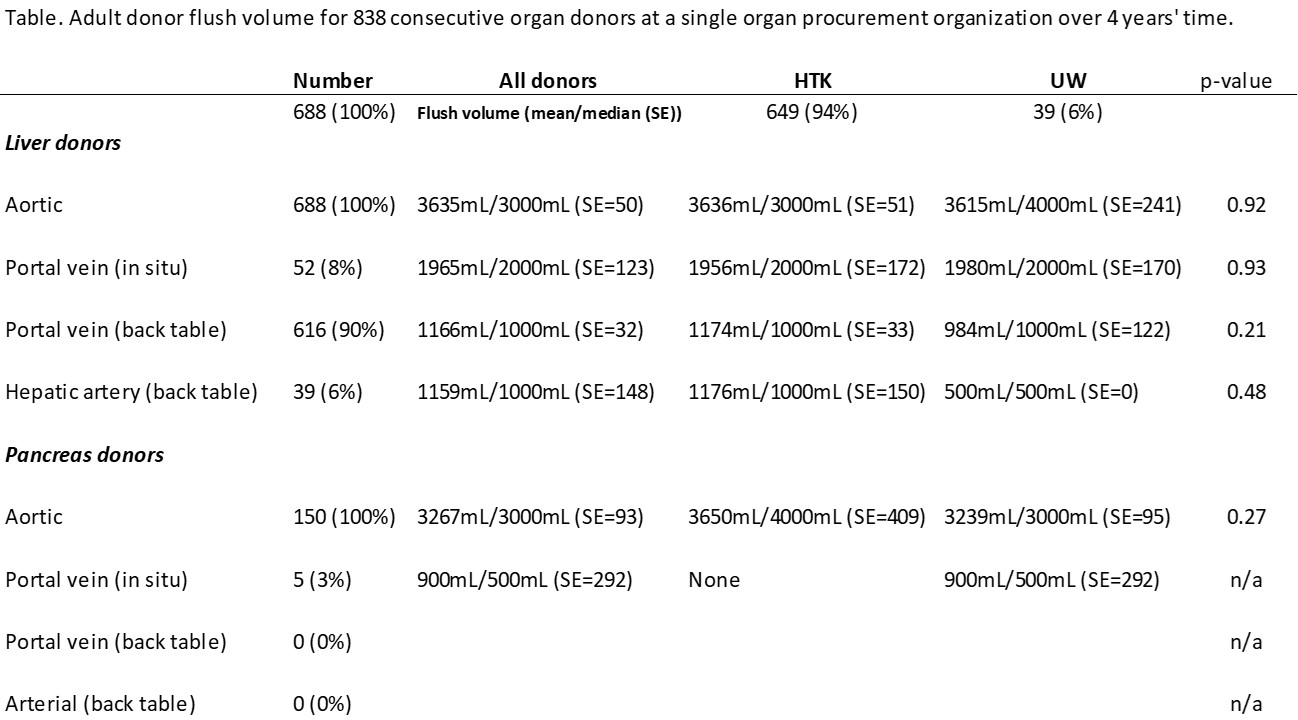Deceased donor organ flush with equivalent volumes of HTK and UW at a single U.S. organ procurement organization
Richard S. Mangus1, Chandrashekhar A. Kubal1, Burcin Ekser1, Plamen Mihaylov1, Andrew Lutz1, Jonathan A. Fridell1.
1Transplant Division, Dept of Surgery, Indiana University School of Medicine, Indianapolis, IN, United States
Introduction: HTK and UW are the two primary solid organ preservation solutions used in the United States, accounting for the preservation of over 95% of all organs procured. These two solutions have been compared in numerous prospective and retrospective studies, consistently showing similar clinical outcomes. In the U.S., they are often used interchangeably in daily clinical practice.
HTK was developed as a low viscosity and high volume solution. UW is considered a high viscosity and low volume solution. Previous studies have suggested that infusing HTK at a low volume results in equivalent clinical outcomes to a high volume HTK flush, but with a significant cost savings. Many centers in the U.S. routinely use a low volume HTK flush. This study analyzes all procurements at a single U.S. organ procurement organization (OPO) to analyze the pattern of use of HTK and UW. This study specifically analyzes the usage for liver and pancreas grafts, as these are the two organs that may be most sensitive to variations in preservation solution and volume.
Methods and Materials: All deceased donor solid organ procurements at a single OPO from 2016 to 2019 were analyzed. The primary preservation solution was recorded, as well as the total volume infused into the aorta and portal vein, as well as on the back table into the hepatic artery and portal vein (or splenic vein for pancreas). Because this was procurement data only, no clinical outcomes were available for the grafts.
Results and Discussion: During the study period, there were 688 liver and 150 pancreas procurements. The majority of the liver grafts were flushed with HTK (n=649, 94%) as that was the solution of choice for the OPO. There were 39 livers (6%) flushed with UW solution. All liver donors received an aortic flush (100%), while 90% had a back table flush of the portal vein. There were 8% which had in-situ flush of the portal vein, and 6% had back table flush of the hepatic artery. The volume of infused solution was compared for HTK and UW. In all cases, the infused volume did not differ statistically with the aortic flush being 3L (HTK) and 4L (UW) (p=0.92). The back table flush was equivalent with 1L for both HTK and UW (p=0.21). In situ portal vein flush was also equivalent with 2L for both HTK and UW (p=0.93).
Regarding pancreas grafts, 100% received aortic flush of the graft, with the HTK flush (4L) higher than the UW flush (3L) (p=0.27). Only 5 grafts received in situ portal vein flush and these were all UW with volume of 0.5L.

Conclusions: These data demonstrate that HTK and UW are being infused at equivalent volumes in daily clinical practice at one OPO. These results represent the clinical decision of surgeons from over 20 transplant centers from throughout the U.S. As a cost saving measure, these data suggest that it is possible to have good clinical outcomes with low volume HTK flush and this practice has clearly already been adopted by a large number of centers.
Indiana Donor Network.
There are no comments yet...